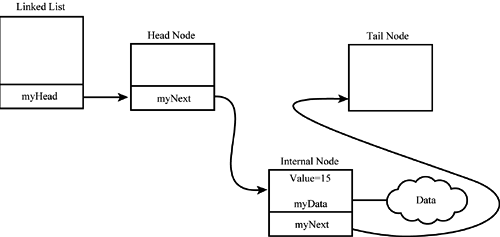The Component Parts
The linked list will consist of nodes. The node class itself will be abstract; we'll use three subtypes to accomplish the work. There will be a head node whose job is to manage the head of the list, a tail node (guess what its job is!), and zero or more internal nodes. The internal nodes will keep track of the actual data to be held in the list.
Note that the data and the list are quite distinct. You can, in theory, save any type of data you like in a list. It isn't the data that is linked together; it is the node that holds the data that is linked.
The program doesn't actually know about the nodes; it only works with the list. The list, however, does little work; it simply delegates to the nodes.
Listing 19.1 shows the code; we'll examine it in excruciating detail:
Listing 19.1. Linked List
What value? (0 to stop): 5 What value? (0 to stop): 8 What value? (0 to stop): 3 What value? (0 to stop): 9 What value? (0 to stop): 2 What value? (0 to stop): 10 What value? (0 to stop): 0 2 3 5 8 9 10
For illustration purposes, the class Data is created on lines 27–36, and the Compare() method is implemented on lines 40–48. A Data object holds a value and can compare itself with other Data objects. It also supports a Show() method to display the value of the Data object.
The easiest way to understand the workings of the linked list is to step through an example of using one. On line 199 the main program is declared, on line 201 a pointer to a Data object is declared, and on line 203 a local linked list is defined.
When the linked list is created, the constructor on line 187 is called. The only work done in the constructor is to allocate a HeadNode object and to assign that object's address to the pointer held in the linked list on line 180.
This allocation of a HeadNode invokes the HeadNode constructor shown on line 158. This in turn allocates a TailNode and assigns its address to the head node's myNext pointer. The creation of the TailNode calls the TailNode constructor shown on line 128, which is inline and does nothing.
Thus, by the simple act of allocating a linked list on the stack the list is created, a head and a tail node are created, and their relationship is established, as illustrated in Figure 19.2.
Figure 19.2. The linked list after it is created.

Line 207 begins an infinite loop. The user will be prompted for values to add to the linked list. He can add as many values as he likes, entering 0 when he is finished. The code on line 211 evaluates the value entered; if it is 0, it breaks out of the loop.
If the value is not 0 a new Data object is created on line 213, and that is inserted into the list on line 214. For illustration purposes, assume the user enters the value 15. This invokes the Insert method on line 193.
The linked list immediately delegates responsibility for inserting the object to its head node. This invokes the method Insert on line 165. The head node immediately passes the responsibility to whatever node its myNext is pointing to. In this (first) case, it is pointing to the tail node. (Remember, when the head node was born, it created a link to a tail node). This therefore invokes the method Insert on line 137.
TailNode::Insert knows that the object it has been handed must be inserted immediately before itself—that is, the new object will be in the list right before the tail node. Therefore, on line 139 it creates a new InternalNode object, passing in the data and a pointer to itself. This invokes the constructor for the InternalNode object, shown on line 87.
The InternalNode constructor does nothing more than initialize its Data pointer with the address of the Data object it was passed and its myNext pointer with the node's address it was passed. In this case, the node it will point to is the tail node. (Remember, the tail node passed in its own this pointer.)
Now that the InternalNode has been created, the address of that internal node is assigned to the pointer dataNode on line 139, and that address is in turn returned from the TailNode::Insert() method. This returns us to HeadNode::Insert(), where the address of the InternalNode is assigned to the HeadNode's myNext pointer (on line 167). Finally, the HeadNode's address is returned to the linked list where, on line 195, it is thrown away (nothing is done with it because the linked list already knows the address of the head node).
Why bother returning the address if it is not used? Insert is declared in the base class, Node. The return value is needed by the other implementations. If you change the return value of HeadNode::Insert(), you will get a compiler error; it is simpler just to return the HeadNode and let the linked list throw its address on the floor.
So what happened? The data was inserted into the list. The list passed it to the head. The head blindly passed the data to whatever the head happened to be pointing to. In this (first) case the head was pointing to the tail. The tail immediately created a new internal node, initializing the new node to point to the tail. The tail then returned the address of the new node to the head, which reassigned its myNext pointer to point to the new node. Hey! Presto! The data is in the list in the right place, as illustrated in Figure 19.3.
Figure 19.3. The linked list after the first node is inserted.

After inserting the first node, program control resumes at line 209. Once again the value is evaluated. For illustration purposes, assume that the value 3 is entered. This causes a new Data object to be created on line 213 and to be inserted into the list on line 214.
Once again, on line 195 the list passes the data to its HeadNode. The HeadNode::Insert() method in turn passes the new value to whatever its myNext happens to be pointing to. As you know, it is now pointing to the node that contains the Data object whose value is 15. This invokes the InternalNode::Insert() method on line 96.
On line 100, the InternalNode uses its myData pointer to tell its Data object (the one whose value is 15) to call its Compare() method, passing in the new Data object (whose value is 3). This invokes the Compare() method shown on line 40.
The two values are compared; and, because myValue will be 15 and theOtherData.myValue will be 3, the returned value will be kIsLarger. This will cause program flow to jump to line 107.
A new InternalNode is created for the new Data object. The new node will point to the current InternalNode object, and the new InternalNode's address is returned from the InternalNode::Insert() method to the HeadNode. Thus, the new node, whose object's value is smaller than the current node's object's value, is inserted into the list, and the list now looks like Figure 19.4.
Figure 19.4. The linked list after the second node is inserted.

In the third invocation of the loop, the customer adds the value 8. This is larger than 3 but smaller than 15, and so should be inserted between the two existing nodes. Progress will be exactly like the previous example except that when the node whose object's value is 3 does the compare, rather than returning kIsLarger, it will return kIsSmaller (meaning that the object whose value is 3 is smaller than the new object, whose value is 8).
This will cause the InternalNode::Insert() method to branch to line 116. Rather than creating a new node and inserting it, the InternalNode will just pass the new data on to the Insert method of whatever its myNext pointer happens to be pointing to. In this case, it will invoke InsertNode on the InternalNode whose Data object's value is 15.
The comparison will be done again, and now a new InternalNode will be created. This new InternalNode will point to the InternalNode whose Data object's value is 15, and its address will be passed back to the InternalNode whose Data object's value is 3, as shown on line 118.
The net effect is that the new node will be inserted into the list at the right location.
If at all possible, you'll want to step through the insertion of a number of nodes in your debugger. You should be able to watch these methods invoke one another, and the pointers be properly adjusted.
